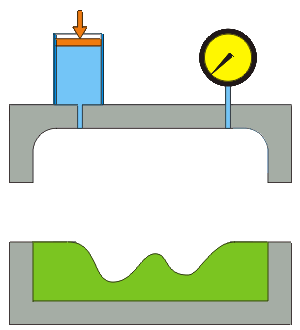Hydroforming Manufacturing Review
Hydroforming Manufacturing Review
Hydroforming (or hydramolding) is a cost-effective method of shaping metals into lightweight, structurally stiff and strong components. Tthe automotive industry is one of the largest applicators of hydroforming, which makes use of the complex shapes possible by hydroforming to produce stronger, lighter, and more rigid unibody structures for vehicles. The hydroforming manufacturing technique is frequently employed in the shaping of aluminium tubes for bicycle frames and sheet metal panels..
Hydroforming uses a specialized type of die combined with high pressure hydraulic fluid to deform the metal at room temperature into a shape forming die. To hydroform aluminum into a vehicle's frame rail, a hollow tube of aluminum is placed inside a negative form that has the shape of the desired end geometry. High pressure liquid is then hydraulically injected inside the aluminum which causes it to expand until it yeilds and deforms taking the shape of the forming die. The hydroformed aluminum is then removed from the forming die.
 |
|---|
This process is based on the 1950s patent for hydramolding by Milton Garvin of the Schaible Company of Cincinnati, OH. It was originally used in producing kitchen spouts. This was done because in addition to the strengthening of the metal, hydramolding also produced less "grainy" parts, allowing for easier metal finishing.
Hydroforming Sheet - In hydroforming sheet there is Bladder forming (where there is a bladder that contains the liquid, no liquid contacts the sheet) and hydroforming where the fluid contacts the sheet (no bladder). A work piece is placed on a draw ring (blank holder) over a male punch then a hydraulic chamber surrounds the work piece and a relatively low initial pressure seats the work piece against the punch. The punch then is raised into the hydraulic chamber and pressure is increased to until the pressure forms the part around the punch. Then the pressure is released and punch retracted and hydraulic chamber lifted and the process is complete.
Tube hydroforming - In tube hydroforming there are two major practices: high pressure and low pressure: With the high pressure process the tube is fully enclosed in a die prior to pressurization of the tube. In low pressure the tube is slightly pressurized to a fixed volume during the closing of the die. In tube hydroforming pressure is applied to the inside of a tube that is held by dies with the desired cross sections and forms. When the dies are closed on the tube the ends are sealed and the tube is filled with hydraulic fluid the internal pressure causes the tube to conform to the dies.
Pressure required during hydroforming operations depends on:
- Material Yield Strength
- Material wall thickness
- Inside radius of the chartpest cross-sectional corner
Materials used in Hydroforming:
- Aluminum (Aluminium)
- Brass
- Steel
- Copper
- Stainless Steel
- Inconel
- Exotic Materials (Waspalloy, Hastelloy), High Nickel Steels)
Geometries that are typically Hydroformed:
- Automotice sheetmetal
- Complex shapes from cylinders
- Pipe tees
- Bycycle handle bars
- Bellow shapes